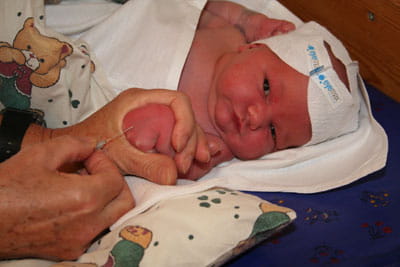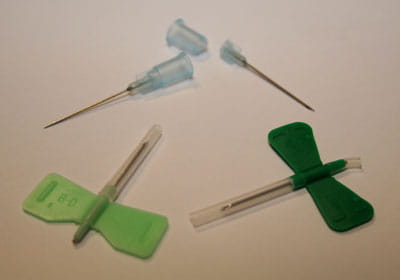Drawing Blood From Infants Heel
Heel or back of the hand?
"Open venous sampling from the back of the hand is less painful for infants, and that also includes premature babies", says Brit Valaas Viddal, Norwegian biomedical laboratory scientist, at the hospital Ålesund Sjukhus.
She very strongly advocates sampling from the back of the hand, and she has recently trained the biomedical laboratory scientists at the hospital Haukeland Sjukhus in the technique.
Two minutes before collecting the sample, the infant is given sugar water and the back of the hand is warmed up, if the biomedical laboratory scientist considers it necessary.
The biomedical laboratory scientist uses an ordinary injection needle, but cuts off the plastic cover where drops of blood will accumulate, before sampling to prevent blood going to waste. The procedure does not require stasis and the microtube is filled drop by drop.
 |
| Norway: Sampling from the back of the hand of the baby, as practiced in some Norwegian hospitals. |
Head biomedical laboratory scientist, Hanne Homann, from the hospital Århus Universitetshospital Skejby finds the Norwegian technique interesting, but not convincing enough for her department to begin reorganizing their procedures.
She doubts whether the technique is gentler for the little ones than a common heel lance. She thinks that it will be more resource-demanding and that it is unhygienic.
The Danish trade magazine dbio (www.dbio.dk) has presented Brit Valaas Viddal with the doubts of her Danish colleague.
LESS PAIN AND CALMER BABIES
"I find it difficult to believe that the babies lie as still during sampling as described in an article from the Norwegian trade magazine Bioingeniøren (The Bioengineer, www.nito.no), even when given sugar water, which we also do at Århus Universitetshospital Skejby.
Furthermore, I seriously doubt whether it is less painful for the baby. We know from ourselves how painful a puncture in the back of the hand is compared with sampling in the arm, and I wonder if that is not also the case for the infants?" Hanne Homann asks.
 |
| Denmark: Heel lance from 5-day-old infant. The sample will form part of the PKU bank at the Danish Statens Serum Institut (www.ssi.dk), which prevents and controls infectious diseases and congenital disorders. |
Brit Valaas Viddal explains that she and her biomedical laboratory scientist colleagues were also skeptical when they began drawing samples from the back of the hand after the Norwegian nurses had put pressure on them, because the nurses believed it was less painful for the babies.
"I soon realized that my skepticism was unfounded. The sampling takes some training, but when you master it, the babies show only few indications of pain.
Now and then they react to the puncture, but holding their hand compared with firmly holding their foot, is clearly less uncomfortable for them", Brit Valaas Viddal explains. "Of course the sugar water is part of a whole that makes sampling less painful, but as I mentioned, being held by the foot is worse than being held by the hand".
"But what do you do when you have to draw a large number of samples from a newborn baby? Do you draw them all from the back of the hand?" Hanne Homann asks.
"Of course it depends on the requested tests. If possible, we also collect venous samples from the bend of the arm with a normal closed sampling system. The ammonia test must be collected with a closed system and several of the hormone and coagulation tests require special conditions.
When collecting chromosome samples, we generally try to take them from the bend of the arm but if this for some reason is difficult we use the back of the hand of the baby and let the blood drops dribble into the tube.
In these cases we always indicate the method of sample collection on the order form. But if we have to choose between a sample from the heel and a venous sample from the back of the hand, we choose the latter", Brit Valaas Viddal explains.
 |
| Various needles for open venous sampling from infants: the special needle Neosyte (light green), cut-off ordinary butterfly needle (dark green) and injection needle size 23G, cut off if necessary. |
NOT MORE TIME-CONSUMING
Another of Hanne Homann's objections to the Norwegian technique is that it is more time-consuming in her opinion.
"I don't understand that the biomedical laboratory scientists have resources for sampling from the back of the hand, which requires much more time than capillary sampling from the heel. At the hospital Århus Universitetshospital Skejby, for example, they often order many tests from one sample and therefore we have to fill several microtubes/capillary tubes at a time. In my opinion it will take less time from the heel compared with the back of the hand, from where the blood flows drop by drop. When performing a heel lance, it is possible to gently "milk" the heel so that the sampling is sped up", says Hanne Homann.
Brit Valaas Vidaal: "With a good venepuncture it is possible to fill many tubes; actually, several tubes can be filled without any problems compared with capillary sampling".
But what about the hygiene? "I consider it significantly more hygienic to perform a heel lance compared with a venepuncture where the vein stays "open" after sampling", says Hanne Homann.
"Yes", the Norwegian biomedical laboratory scientist acknowledges:
"Open venous sampling is more messy. That is why I always use a diaper or some paper to collect the first drops. I still think there are so many other positive aspects to the technique, that makes it my first choice when sampling from newborn babies. Once in a while, of course, you have to use heel lance, but I suppose the most positive thing for us as biomedical laboratory scientists is to have the option to always decide what is best for the baby".
Blood sampling from infants – Practice in Denmark
A survey in major Danish hospitals shows that the vast majority use both capillary and venepuncture on newborn babies and infants, depending on the type of tests requested. Heel lance is the preferred method in the case of common tests like PKU, etc. Venepunctures in the bend of the arm are performed on infants as well as neonates when large amounts of blood are needed or when doing special analyses, such as blood culture, unraveling metabolic diseases, hematocrit, etc.At the vast majority of the hospitals in the survey the biomedical laboratory scientist never collect samples from the back of the hand of babies.
Herning and Sønderborg: Mainly venepunctures
Two places in Denmark differ:
At the hospital Herning Sygehus, Clinical Biochemical Department, the biomedical laboratory scientists primarily sample by venepuncture with an open sampling system and microtubes. The samples are collected from the bend of the arm or in some cases from the back of the hand of the infants. In some cases they also collect capillary blood from the heel, e.g. for PKU tests.
The biomedical laboratory scientists from this department have done that for many years because they believe that venepuncture is less painful for babies, the sampling is fast and the quality of the sample better.
In 2002 the magazine dbio had an article from Herning Sygehus where two biomedical laboratory scientist students in their final project showed that venepuncture gives better results. You can read the Danish article from 2002 at www.dbio.dk.
At the hospital Sønderborg Sygehus, Clinical Biochemical Department, the biomedical laboratory scientists also primarily sample by venepuncture from the bend of the arm of the baby. The department is currently discussing with the nurses if samples in the future should be taken from the back of the hand of the baby instead of the arm. At this hospital the biomedical laboratory scientists also sometimes collect capillary blood from the heel.
READ MORE ABOUT OPEN VENOUS SAMPLING FROM THE BACK OF THE HAND
- Shah V, Ohlsson A. Venepuncture versus heel lance for blood sampling in term neonates. Cochrane Database of Systematic Reviews 2004, Issue 4. Art. No.: CD001452. DOI: 10.1002/14651858.CD001452.pub2.
http://www.mrw.interscience.wiley.com/cochrane/clsysrev/
articles/CD001452/frame.html
Venepuncture, when performed by a skilled practitioner, is less painful than heel lance for taking blood samples in newborn babies. - http://www.nito.no
PowerPoint presentation by Brit Valaas Viddal (in Norwegian) from a course on open venous sampling: http://www.nito.no/dm/public/123721.PDF. A short instruction film on open venous sampling (7 MB, 01:01 minutes): http://www.nito.no/PageFiles/33444/Åpen%20venøs%20prøvetaking%20av%20nyfødtscreening.avi. - http://www.bioingenioren.no
Articles about open venous sampling from infants and premature babies in the trade magazine of Norwegian biomedical laboratory scientists Bioingeniøren no. 11. 2006 (http://www.nito.no/templates/page____27754.aspx) and no. 1. 2007 (http://www.nito.no/templates/page____28953.aspx). In Norwegian.
Disclaimer
May contain information that is not supported by performance and intended use claims of Radiometer's products. See also Legal info.
Drawing Blood From Infants Heel
Source: https://acutecaretesting.org/en/articles/heel-or-back-of-the-hand
Posted by: keithbourfere.blogspot.com

0 Response to "Drawing Blood From Infants Heel"
Post a Comment